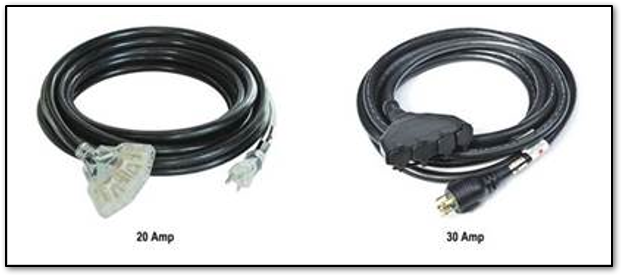Read the manual thoroughly and understand all of the instructions, cautions, and warnings before using this equipment. If any section of the manual is not understood, contact your nearest authorized dealer, or contact Generac Customer Service at 1-888-436-3722 (1-888-GENERAC), or www.generac.com with any questions or concerns.
Power Cords vs. Extension Cords:
How to select the right power cord and extension cord for your portable generator.
This article addresses the importance of selecting the right power and extension cords to avoid safety hazards and power outages. Generac provides a simple guide on how to select the right power and extension cords, including sizing and plug configurations, and safety tips to keep in mind.
Environment
This article applies to power and extension cords for all portable generators.
Simplifying power connections for your portable generator
Generac extension cords are a great solution to the drawbacks of traditional extension cords. Rather than having to run multiple extension cords, Generac's single extension cords allow the user to run one cord for multiple appliances. To use these cords, simply plug the extension cord into the appropriate outlet on the generator and run it inside the home through an open door or window. The plug on the inside of the home splits into either 3 or 4 120V outlets, allowing the user to plug in several household appliances to a single cord.

Here are some other useful tips when sizing the extension cord that you need for your generator:
- For a generator with a 30A twist-lock receptacle (L14-30R), you will need the 30A cord (model 6112).
- This 20ft cord will plug into the generator's L14-30 receptacle.
- The opposite end of this cord will then split into four 5-20 receptacles to power appliances within the home.
- For a generator with a 20A, 120V receptacle, use the 20A cord (model 7684), and the opposite end of this 25ft cord will then split into three 5-20 receptacles to power appliances within the home.
Sizing the extension cord for your generator is simple, and with Generac's single extension cords, it's even easier to power your appliances safely and conveniently.
How to select the proper power cord for your portable generator
When using a portable generator, it's important to understand that traditional extension cords can only power appliances that have a cord. Hardwired appliances such as furnace, fans, well pumps, and water heaters, will not be able to be powered. Here are some simple steps to follow when selecting the proper power cord.

1. Select a cord with the proper amperage.
- While portable generators are measured by watts, power cords are measured in amps.
- The larger the amperage, the thicker the cord will be.
- Each outlet on the generator has a certain amperage capability.
- Select the power cord whose amperage matches the amperage of the outlet being used.
2. Select the right plug configuration.
- Plugs and outlets are designed in different configurations to help prevent an electrical overload.
- Pay special attention to the configuration if you have a 30A or 50A outlet.
- For example, 30A plugs come in two varieties: 3-prong and 4-prong.
- If you have a 50A outlet on the generator, you will most likely need a special power cord with two different ends.
- Be sure to select a cord whose configuration matches the configuration of the outlet being used.
- If you have an L14-50 receptacle, the cord will need to have an L14-50 plug in order to connect.

Safety First: Tips for Properly Using Extension Cords and Power Cords with Your Portable Generator
It's crucial to follow safety guidelines to prevent any accidents when using extension cords and power cords with your portable generator. Here are some tips to keep in mind:
- Always select cords rated for outdoor use.
- Before connecting appliances, double-check that the power cord is undamaged, including cuts and frays.
- A damaged cord can result in an electric shock.
- Ensure that you have the proper cord length.
- Select a cord long enough to keep the generator at least 20 feet away from your home.
- Keep the generator away from windows and doors.
- Always start the generator before plugging in an extension cord.
- Otherwise, you risk putting unnecessary strain on the generator and damaging it.
By taking note of the cord's amps and configuration and following safety precautions, you can safely and conveniently use your portable generator and stay powered.



